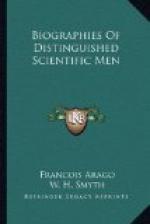In a subsequent series of experiments, some globules of silver placed very far from the observer, allowed their globular form to be perceived, even when the magnified angle remained below two minutes.
Under equality of subtended angle, then, the telescopic vision with strong magnifying powers showed itself superior to the naked eye vision. This result is not unimportant.
If we take notice of the magnifying powers used by Herschel in these laborious researches, powers that often exceeded five hundred times, it will appear to be established that the telescopes possessed by modern astronomers, may serve to verify the round form of distant objects, the form of celestial bodies even when the diameters of those bodies do not subtend naturally (to the naked eye), angles of above three tenths of a second: and 500, multiplied by three tenths of a second, give 2’ 30”.
Refracting telescopes were still ill understood instruments, the result of chance, devoid of certain theory, when they already served to reveal brilliant astronomical phenomena. Their theory, in as far as it depended on geometry and optics, made rapid progress. These two early phases of the problem leave but little more to be wished for; it is not so with a third phase, hitherto a good deal neglected, connected with physiology, and with the action of light on the nervous system. Therefore, we should search in vain in old treatises on optics and on astronomy, for a strict and complete discussion on the comparative effect that the size and intensity of the images, that the magnifying power and the aperture of a telescope may have, by night and by day, on the visibility of the faintest stars. This lacuna Herschel tried to fill up in 1799; such was the aim of the memoir entitled, On the space-penetrating Power of Telescopes.
This memoir contains excellent things; still, it is far from exhausting the subject. The author, for instance, entirely overlooks the observations made by day. I also find, that the hypothetical part of the discussion is not perhaps so distinctly separated from the rigorous part as it might be; that disputable numbers, though given with a degree of precision down to the smallest decimals, do not look well as terms of comparison with some results which; on the contrary, rest on observations bearing mathematical evidence.
Whatever may be thought of these remarks, the astronomer or the physicist who would like again to undertake the question of visibility with telescopes, will find some important facts in Herschel’s memoir, and some ingenious observations, well adapted to serve them as guides.
FOOTNOTES:
[18] Conforming to general usage, and to Sir W. Herschel himself, we shall allude to this instrument as the forty-foot telescope, though M. Arago adheres to thirty-nine feet and drops the inches, probably because the Parisian foot is rather longer than the English.—Translator’s Note.




